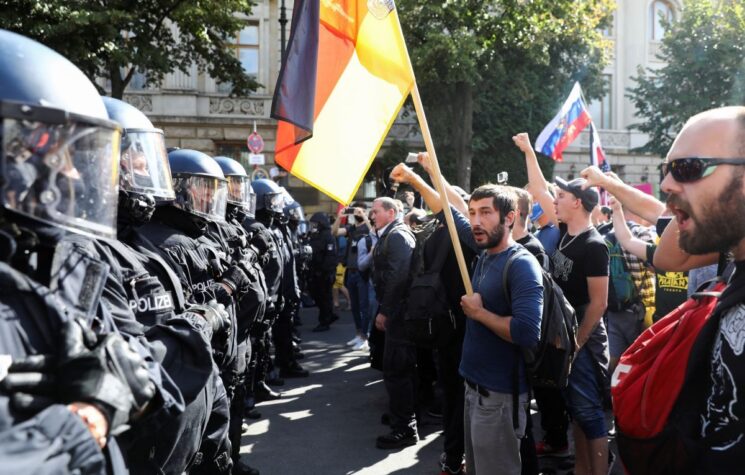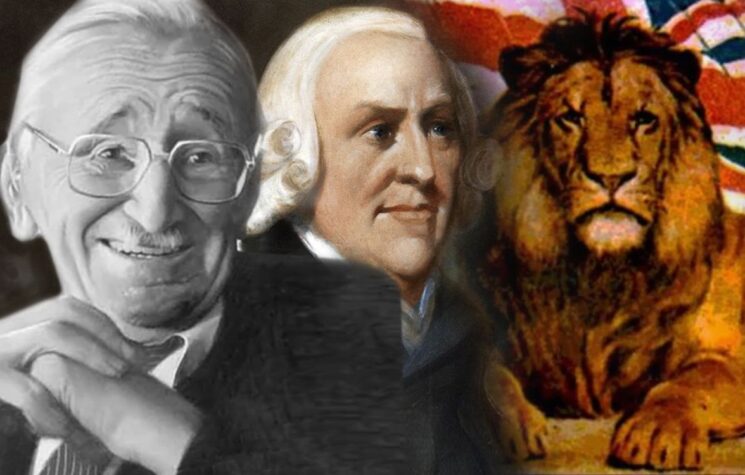Sometimes people are too quick to criticize, but other times they aren’t quick enough. A case in point is “Freedom for Humanity,” a mural that caused a fair-sized stir when an artist known as Mear One painted it on a London wall in 2012.
The problem? The work showed a group of capitalists sitting around an oversized Monopoly board resting on the bent backs of four naked men of various hues. With their mustaches, jowls, and protuberant noses, the half-dozen white men looked, well, a bit Semitic, and, indeed, Mear One revealed in an interview that two of the portraits were indeed of Jews, i.e. Lord Rothschild and Paul Warburg. (The others were John D. Rockefeller, J.P. Morgan, Andrew Carnegie, and, for some reason, the writer and mystic Aleister Crowley.)
Charges flew that the painting was anti-Semitic because it equated Jews and exploitation, and the usual angry chorus arose. But then the fuss died down, and everyone moved on. And why not? People are busy, they’ve got other things on their mind, and, besides, who wants to get into a battle over something as explosive as anti-Semitism? As George Orwell once observed, “It is almost impossible to mention Jews in print, either favorably or unfavorably, without getting into trouble.” So people kept their heads low, and “Freedom for Humanity” was soon forgotten.
But now the incident seems like one of the seminal events of the early twenty-first century. The reason is that it turned out to enjoy a curious after-life. A half-dozen years later, a right-wing Labor Party member – yes, such things do exist – named Luciana Berger went gunning for the embattled leftists Jeremy Corbyn and discovered that he had been among those rising to Mear One’s defense. “You are in good company,” Corbyn tweeted the artist – in reality, an American named Kalen Ockerman – at the time. “Rockefeller destroyed Diego Viera’s mural because it includes a picture of Lenin.”
Actually, it was Diego Rivera, the Mexican muralist best known today as the husband of Frida Kahlo. But bungling an artist’s name is not what got Corbyn into trouble. Rather, it was failing to show requisite sensitivity to an aggrieved minority group. Berger and her supporters went into action, charging that Corbyn’s blasé approach was typical of a Labor Party riddled with anti-Semitism. Corbyn was suspended, and members were purged for the crime of “denialism,” i.e. arguing that the problem was not as extensive as Berger & Co. said it was. With party leaders warning that “thousands and thousands” would get the ax if they didn’t stop engaging in similar thought crimes, the mood was less London in the year 2020 than Moscow back in 1937 when the entire Old Bolshevik leadership found itself on the chopping block due to equally vague and paranoid charges.
From a scratch to the danger of gangrene, as Trotsky once said. But lost amid the sturm und drang was an all-important question. Was “Freedom for Humanity” really as bad as everyone said? Was it indeed the second coming of Mein Kampf or merely an honest and well-intended statement about human suffering in an age of runaway exploitation?
The answer is the latter, which is why the controversy deserves a second look.
Mear One’s painting is not a subtle work. But, then, neither was Diego Rivera’s Rockefeller Center mural, which he was able to recreate in Mexico City under the title, “Man, Controller of the Universe,” and which “Freedom for Humanity” vaguely resembles. But while both feature workers, decadent bourgeois, and industrial machinery, the tone is different. Where Rivera, good Marxist that he was, was fundamentally optimistic in his depiction of workers and peasants building a new society, Mear One is less concerned with the world to come than the world as it currently exists. Hence his images are glummer and more downbeat.
This may indicate a certain decline in political imagination from Rivera’s day. But that’s not the issue, of course. Rather, it’s whether the half-dozen portraits at its center are anti-Semitic. The answer is yes – if, that is, you assume that every jowly old white man with a protuberant nose is Jewish. But if that’s the case, then what about Jimmy Durante, a.k.a the Schnozz, born of Italian Catholic immigrants on New York’s Lower East Side? Or W.C. Fields, the offspring of impeccable Anglo-Saxon Protestant stock from small-town Pennsylvania, whose proboscis is equally as prominent?
Or the actor Robert Morley for that matter? Or Rembrandt? Since none are Jewish, the answer is therefore no. As for Warburg and Lord Rothschild, yes, they’re Jewish, but what of it? Are Mear One’s critics saying that no Jews are to be found in the ranks of the bourgeoisie? Are they calling for a strict quota system in which they can only be depicted in strict proportion to their membership? Or are they saying that artists must not depict reality at all, but must airbrush it so as to remove any and all images that someone, somewhere, might find offensive?
All of which is nonsense. “Freedom for Humanity” is not racist, and the entire episode was not about anti-Semitism, but about stirring up hysteria in order to whip people into line. After all, criticizing Israel is verboten as far as Anglo-American ruling elites are concerned. Since a way had to be found to silence dissidents, what hotter button could there be to push than that of anti-Semitism? The world has moved on since the days of Dachau and the Gulag, and methods of control are no longer as brutal. But they’re still effective nonetheless.
So if people had been quicker on the draw back in 2012, if they’d argued that anti-Semitism is too important to be tossed around in such a light-hearted way, then maybe demagogues wouldn’t have wound up with such a free hand. It’s vital to nip such tendencies in the bud before they turn into a full-scale witch hunt, which is precisely the case today.











































